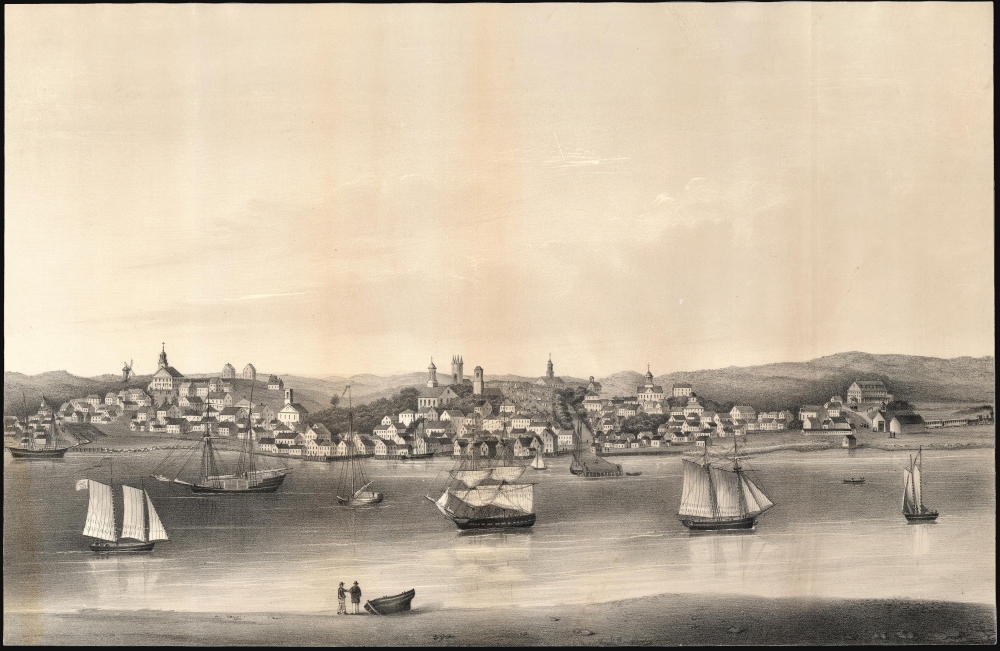1851 Bufford/ Barry View of Plymouth, Massachusetts
Plymouth-barry-1851
Title
1851 (undated) 13 x 19.75 in (33.02 x 50.165 cm)
Description
A Closer Look
The view presents the small town as seen across its harbor; sailboats ply its waters. On the beach in the foreground a pair of boatmen observe the scene. As bucolic as the view is, it was not a retrospective piece: the view presents the town as it would have been seen in the second half of the 1840s. It focuses particularly on the town's churches: the 1826 Unitarian Church (no longer surviving), First Church Unitarian (built in 1831, burned in 1892, replaced in 1899) and Church of the Pilgrimage Congregational built in 1840 (still standing!). Atop the eastern hill of the town, to the left of the view, is one of the few surviving depictions of the First Baptist Church of Plymouth: the structure was built in 1821 between Summer and High Streets. During the 1840s it was a meeting place for the Old Colony Anti-Slavery Society. (Its use as a convention hall is an indication of its size.) The church was destroyed by fire in 1861. In the background to the left of First Baptist is a windmill. This represents a puzzle, as the nearest contemporary detailed maps of Plymouth we can find - the 1832 and 1846 iterations of Thatcher's 'A map of Plymouth Village' - do not specifically note any windmill despite its depiction of many of the mills along Town Brook.The courthouse, built in 1821, is pictured. The large structure at right, Samoset house, had been built in 1844. To the right, a train can be seen leaving town: The Old Colony Railroad, founded in 1844, began serving Plymouth in 1845. The view cannot have been drawn before that year.
Timothy Barry
Virtually nothing is known of the artist. Deak posited that he must have been a resident of the town, a notion supported by the view's careful detail. A shipping agent by that name does exist in census records. Born in Beverly, Massachusetts in 1796, he married in Plymouth; his four children all were born and died in that town, two in infancy. Barry appears to have produced only this view, so if he intended to change his family's fortunes by breaking into the arts, he was probably disappointed.Publication History and Census
This view is rare. Based on its content, Barry cannot have drawn it before 1845. Assuming that the publishers' address is a typographic error, (i.e., 160 Washington Street instead of the printed 260) the view had to have been printed between 1851 and 1855 (the dates Bufford was located on 160 Washington.) We are only aware of a few examples to have reached the market and copies in institutional collections are even more scant. OCLC lists a single copy at the Boston Athenaeum.CartographerS
Timothy Barry (November 11, 1796 - February 8, 1856) was an American artist and shipping agent. We are aware of only one work produced by him - a view of the town of Plymouth, Massachusetts - and we have the scantest conjectural record of his life. A Timothy Barry - listed in the 1855 census as an agent, which was a form of broker - was born in Beverly, Massachusetts, but lived and died in Plymouth. He married Maria Allen in Plymouth in 1822; a daughter and a son both died in infancy (also in Plymouth.) A second daughter would survive the family, while a third daughter would outlive her father by two years. More by this mapmaker...
John Henry Bufford (July 27, 1810 - October 8, 1870) was a Boston based lithographer and printer. Bufford was born in Portsmouth, New Hampshire. He apprenticed as an artist and lithographer at Pendleton Lithography (1825 - 1836) of Boston. In 1835 he relocated to New York where he took independent commissions from George Endicott and Nathaniel Currier, among others. Returning to his hometown of Boston in 1839, he took a position of chief artist with the firm of Benjamin W. Thayer, heir to Pendleton Lithography. He probably married Thayer's sister, Anna Melora Tufts Thayer (1808-1878). Bufford has been highly criticized as an engraver, with one historian, David Tatham, stating he had 'a mediocre sort of craftsmanship at best' and 'no very special skills as an original artist.' We, however, find no justification for this harsh criticism. Instead Bufford gravitated toward business and management. By 1844 Thayer's shop was renamed J. H. Bufford and Company. The firm specialized in decorative sheet music, panoramic views, illustrations for books, retractions of paintings, and commercial printing. Bufford is credited with being one of the first employers and mentors of the important artist and engraver Winslow Homer. Bufford died in 1870, passing on the business to his sons Frank G. Bufford and John Henry Bufford Jr. These young men, operating under the imprint of 'J.H. Bufford's Sons, Manufacturing Publishers of Novelties in Fine Arts', expanded the firm with offices in New York and Chicago. A possibly related lithographic printing firm named Bufford Chandler was incorporated in Boston in 1893. It later relocated to Concord, New Hampshire but closed in 1925 when its state business charter was repealed. Learn More...

